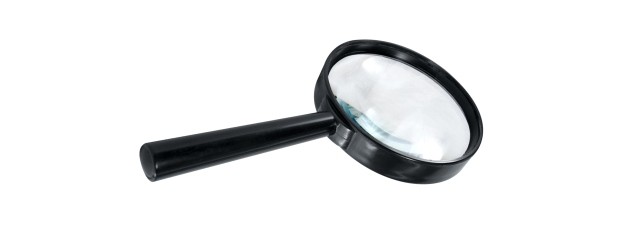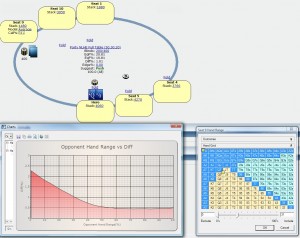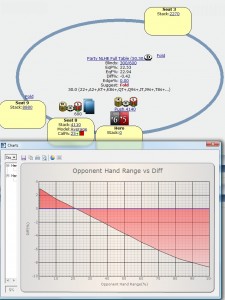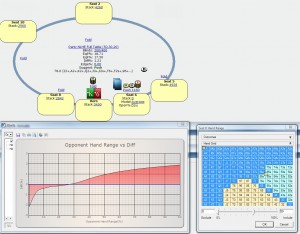Recommended Poker Room
As we have explained in this introduction on the SNG Wizard, the Sit and Go Wizard (download it here)is a tool to import your hand histories and to analyze if you have played mathematically correct during the push or fold phase. This is the late phase of a single table tournament. When the effective stacks (the largest chip stack of a player actively involved in a hand) is less than 10 to 15 big blinds, there are only two ways to play poker: you have to either fold, or to push all-in preflop.
Chips won have less value than chips lost in tournaments such as Sit and Go’s. In order to play correctly, you have to consider the dollar value of chips ($EV) and not the pot odds in terms of chips. Remember: if you win a single table tournament, you will own 100% of all chips that were in play. However, you will only win 50% of the total prize money. This means that the value of one chip has halved during the tourney. This is where the Independent Chip Model (ICM) becomes relevant: it is a mathematical model that converts chip equity into real dollar equity. The model itself is complex. But the good news is that the Sit’n’Go Wizard does the necessary calculations automatically for you.
Ambitious sit and go poker players should use this tool regularly to review their sessions. This helps them to identify leaks in their game and to improve their future game play and ultimately increase their ROI (return on investment).
Let’s have a look at three examples from a SNG Wizard session review in more detail.
SnG Wizard Session Review: SB with Q4s vs. Small Stack in the BB
Hero holds Q4s and sits in the small blind, all other players have folded. After posting the blind, the big blind has 1480 chips left, roughly 3.7BB.
Should hero push with his rather mediocre hand into the big blind to his left?
The analysis with the SNG Wizard shows that hero has to push all-in in any case. The SNG Wizard bases this suggestion on a calling range of the BB of 31%. In 69% of the cases hero wins the blinds uncontested, adding 600 chips to his stack with no risk. In 31% of the cases the push of hero is called. Q4s has an equity of 38.2% against the top 31% hands, according to tools such as the free Poker Stove equity calculator. Combining these probabilities, hero will get called and will lose the hand only once in five pushes.
Of course we have to discuss whether a 31% calling range for the big blind is a realistic value. Perhaps the BB will call only with his top 10% hands, or maybe he will call with his top 80% hands, folding only once in five pushes. But let’s have a look at the graph at the bottom left (“Opponent Hand Range vs Diff”). We see that the equity of a push is positive for our hero for every possible calling range of the enemy! With a 10% calling range, the equity increases by 1.8%, at 31% calling range it increases by 1.0% and a calling range of 80% still results in a positive equity of 0.4%.
If the big blind is very tight, then Hero wins 600 chips uncontested most of the time. If the big blind calls very loose, then Hero holding Q4s will have an acceptable equity against his range. Furthermore, hero can only lose a maximum of 1680 chips, as he has already paid 200 chips when posting the small blind.
To sum up, this SNG Wizard review situation number one is a clear push all-in situation. Our hero would not even have had to look at his cards to decide on the mathematically correct action: push all-in.
SnG Wizard Session Review: SB with 65o vs. Medium Stack in the BB
Let’s look at a second situation on the bubble of a Sit and Go. Our hero is again sitting in the small blind:
In this situation with effective stack of just under 7BB, the SNG Wizard recommends to fold. If the big blind is calling in 25% of the cases, hero is losing 0.42 percentage points of equity. If we look at the chart below the table, we learn that a push is $EV-positive with a calling range of the BB of 21% or less. If the big blinds calls loosely, with 30% of his hands, this push would clearly have a negative equity for our hero. This should be obvious: If the two medium sized stacks clash, the small stack in seat 3 will profit. As a result of this confrontation, he will reach third place almost for sure.
In such situations it is always useful to have a look at the chart at the bottom of the page in order to review the estimated calling ranges of SnG Wizard. The exact range of the enemy can never be estimated. It depends on many factors, for example whether this is the first or the fifth consecutive push from our hero. However, we believe that a fold of hero would have been the better decision than a push.
SnG Wizard Session Review: SB vs. Medium Stack in the BB with K6o
Let’s look at a third example of a situation. Hero is sitting in the big blind and must decide if he should call the push from the small blind or if he should fold:
Here the SN>G Wiz assumes that the SB pushes with the best 59% of the hole cards. This includes hands like T7o and J2s, as we can see from the chart at the bottom right. If the small blind really pushes that loose, hero would have roughly a 50-50% gamble, a coinflip, with his King-Six offsuited. If he wins, the small stack would be eliminated from of the tournament and our hero would advance to the second biggest stack at the table. Calling would correspond to an increase in equity by 1.21 percentage points.
However, if the small blind is pushing tighter, with only the best 25% of all hands, then a call from hero would have a negative expected value. In this situation, much depends on the reads hero has on the small blind. If our hero thinks that the SB pushes more than one third of his hands, he should call. If hero is of the opinion that the SB is pushing less than one quarter of all hands, then he should fold.
Considering how little equity is lost with a hero call against a tight opponent, and how much equity hero can win with a call against a loose opponent, calling is probably the better option for hero if he doesn’t have any reads on his opponent.
SnG Wizard – Recommended Tool for Advanced SNG Players
The SnG Wizard is a tool that every advanced SNG player should use in order to analyze and improve his game in the bubble and final stages of a tournament. This easy-to-use ICM poker tool costs only $99, the equivalent of winning a $20 SNG. Download the fully functional, 30 days free trial version now and start improving your ROI.

 www.
www.


